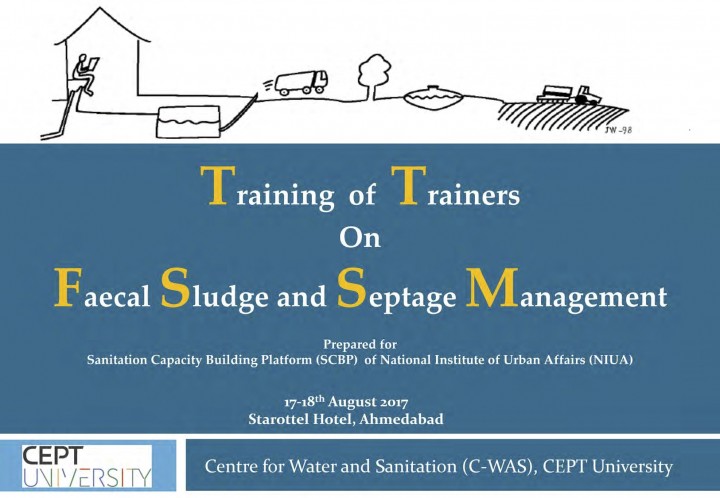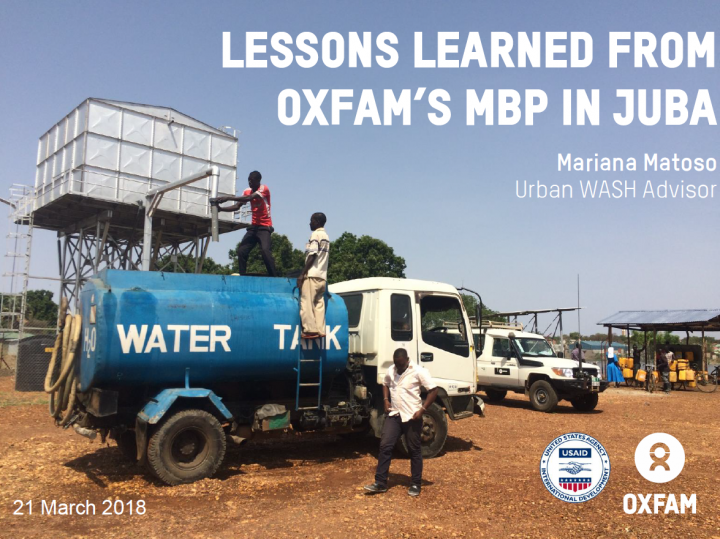Businge, J. (2017) Managing a pit emptying enterprise
Overview of managing a pit emptying enterprise.
Murta, J. (2015) Proceedings of the Learning Event on Urban Sanitation – Professionalization of Emptying Services Urban Sanitation & Hygiene for Health and Development Programme
This report documents the activities from the Learning Event held by SNV Netherlands Development Organisation in Manila, Philippines, from 30 November to 3 December 2015, as part of the Knowledge and Learning component of its Urban Sanitation & Hygiene for Health and Development programme. The event was attended by 39 participants from eight countries, and focused on the ‘professionalization of emptying services’. Learning Event held by SNV Netherlands Development Organization
CEPT University & RCUES, AIILSG (2017) ODF and ODF Sustainability Workshop
Sanitation has been on the forefront of development agenda in India. The Government of India's Swachh Bharat Mission aims to make the whole country Open Defecation Free by 2019. How cities become ODF and what can other cities learn from ODF cities? This was the aim in organising a two day workshop for city officials from Rajasthan. The workshop also included a visit to an […]
Jeevan Pradhikaran, M. (2012) Training modules for WSS capacity building of community groups in rural and small urban areas
This training course series was formulated for capacity building of community groups in rural and small urban areas for operation and maintenance of water supply and sanitation systems in their village/town. There are 3 Modules- "Basics of Water Supply System" provides insights on basics component of water supply system, installation and distribution of water supply systems, estimation and measurement of components of water supply system […]
CEPT University (2017) Training of Trainers on Faecal Sludge and Septage Management
Faecal Sludge and Septage Management has been a neglected area in Indian cities. It has not received attention because of poor understanding of faecal sludge/ septage and lack of proper technical guidance. In this context a training module was developed aimed at training institutes from various states of India that regularly provide training to ULB officials. This two day training programme was developed under the […]
Oxfam (2007) Workshop Alternatif Cara Penyedotan Tinja (Poo Pump) (Indonesian) Alternative Desludging Options (Poo Pump) Workshop
- To introduce alternative options of desludging option (Poo Pump); - To disseminate information the utilization of the poo pump technology; - To obtain general feedback from partners working in sanitation about the implementation of the poo pump technology
UNICEF Nigeria (2008) Trainers Participatory Hygiene and Sanitation Promotion Manual
This step-by-step manual is designed to help personnel involved in the implementation of Water, Sanitation and Hygiene (WASH) activities improve their knowledge and skills to facilitate community engagement processes. The principal aim of this manual is to enable practitioners and facilitators/trainers involved in hygiene promotion to adapt innovative methods in learning, planning with groups and working with communities. The manual is not written on stone, […]
Oxfam (2018) E-voucher programming for flood responses in Bangladesh
Oxfam in Bangladesh implemented an iinovative approach in emergency response through WASH-related market interventions using three models: mobile money transfer, debit card and pre-paid card.
Oxfam (2018) Market Based Flood Preparedness in Jakarta
There were many issues emerged when the flood happened, such as the needs of water, sanitation, latrine and other water and sanitation related needs. To mitigate these problems, Oxfam in partnership with LDMA (Local Disaster Management Agency) DKI Jakarta, are collaborating to find the options for the flood preparedness in WASH sector as well as WASH response options that are giving more role to the […]
German WASH Network (2018) Cash & Markets Learning Event Event Report
The use of cash has undergone significant changes at the field level with the uptake of mulit‐purpose‐cash grants (MPGs). In particular the formation of diverse technical cash working groups (CWGs) raises questions around how the clusters and its partners can provide technical and strategic support to the use of cash modalities in humanitarian response and what structures are needed to facilitate these outcomes. In early […]
Patimo, F., Jones, C. (2016) 'Get a Toilet' Building Demand for Toilets
Unilever convened a group of like-minded companies, NGO’s and research professionals, with expertise in sanitation and marketing and a desire to take immediate action to address this issue. The focus has been on households having access to their own toilet, either inside or outside the home. In particular the low LSM consumer, whose basic needs for food & shelter are met and who have some disposable […]
Mariana Matoso (2018) Lessons Learned from Oxfam’s Market Based Approach to water supply in Juba
This presentation summarises the lessons learnt by Oxfam's team working in Juba to support and develop the local market place to provide drinking water. The programme developed a voucher system that enabled households to access quality drinking water though supporting a community run, solar powered water treatment plant.
Various Authors (2018) 8th Emergency Environmental Health Forum in Berlin, Germany Conference materials
The 8th Emergency Environmental Health Forum (EEHF) event was hosted by the German WASH Network in close collaboration with the Secretariat of the Sustainable Sanitation Alliance (SuSanA) at GIZ. The aim of the 2018 EEHF is: - To share new research and learning - To discuss new approaches and innovation in the sector - To bridge silos between WASH and other humanitarian sectors - To identify research gaps in […]
WSP EAP - Indonesia (2010) Training Modules Sanitation Entrepreneur Training
This manual for using and developing modules is intended as a reference for facilitators of sanitation entrepreneur training courses. This manual contains the curriculums for the modules that form the basis for design of the training modules. It also contains technical details for delivering the topics for each phase. Using this manual, the facilitator should have a firm understanding of what is contained in each […]
USAID HIP (2009) Water, Sanitation and Hygiene Improvement Training Package for the Prevention of Diarrheal Disease Guide for Training Outreach Workers
The USAID- funded Hygiene Improvement Project has compiled a training package to facilitate work in WASH around the world. This training guide is intended for use by any organization the works with outreach workers at the community level.
Amhara National Regional State Health Bureau (2013) Training Manual on Hygiene and Sanitation Promotion and Community Mobilization for Volunteer Community Health Promoters (VCHP) Draft
This session will help participants visualize the role of the Volunteer Community Health Promoters and the link between WASH and healthy living in their communities. Participants will observe, discuss and analyze the roots of fecal contamination and its effect on the health and identify barriers that can improve the well being of all community members. Sponsored by WSP and USAID.
Shafeeqa, F., Shazna, M., Glen, E., Henderson, R. (2008) Training Manual Good water, sanitation and environmental hygiene practices for primary schools
This training manual is a practical guide to be used by teachers and school health assistants who are involved in the promotion of water, sanitation and hygiene practices (WASH). School WASH education is a specific part of the wider school health education program that deals only with water and sanitation-related health problems in and around the school. The manual has been designed to provide the necessary […]
CAWST (2015) Environmental Sanitation Workshop (in English, French and Spanish)
This collection contains the resources for both trainers and participants for the Environmental Sanitation workshop. This two-three day workshop is designed for WASH, community development and health organizations. The workshop explores the relationship between environmental sanitation, disease transmission and health. It addresses technical topics such as human excreta management including different latrine designs; animal excreta management; solid waste management; vector control for mosquitos and rodents; […]
SuSanA (2014) Reinvent the Toilet Fair in India Exhibition tour videos
This library entry consists of a video interview / tour during the Reinvent the Toilet Fair in Delhi, India (21 to 22 March 2014). To watch more videos, please go to links below.
ARTE TV (2014) Urine use in China as fertiliser for apple trees (Scott Chen) from documentary Urine Superpowers
ARTE aired the Urine Superpowers in Germany and France on 14 November 2014




















